Here you will find the 2014 ReelLIFE SCIENCE Primary and Secondary school video topics. Teachers and students can select a topic and decide what they are going to focus on for their particular 3 minute video. Check out our Teachers’ Tips page for advice on preparing, making and submitting your video online before the October 17th deadline.
2014 Primary School Topics
- ‘The Power of Science’
- ‘The Food we Eat’
- ‘Science in the Garden’
- ‘Our Marine World’
- ‘The Science of Exercise’
2014 Secondary School Topics
- ‘Science Heroes’
- ‘Exploring the Cell’
- ‘Medicines’
- ‘Physics in Real Life’
- ‘Vision’ in partnership with VISICORT
This year, to give you more information about the different topics and perhaps give you some ideas for your video, we’re delighted to be able to showcase some of the best scientific research being carried out in NUI Galway, via a weekly series of articles by the researchers themselves.
First up, is Linda Connor, an MSc student working with Advance Science and the Glycoscience Research Group, who writes about her research into honeybee health, under the ‘The Food we Eat‘ topic:
Feeding the World – How Honeybees Help Us

Pollination is an essential step in growing plants, even those we eat such as strawberries, apples and cucumbers. Honeybees are important pollinators, and every year, hives of honeybees are moved around different areas to pollinate different plants. For example, each year, half of the whole population of hives in the US (about a million hives) are moved to almond plantations to pollinate all the almond trees. In Ireland, the value of pollination is estimated at €53 million, whilst the worldwide value is €153 billion.

Without honeybees, we would have a hard time growing crops for us to eat. But as well as being important for agriculture, honeybees also provide us with honey. Bees collect nectar from flowers and bring it back to the hive for transformation to honey. This forms part of a bee’s diet as well as pollen that is also collected from flowers. A lot of work goes into the production of honey – it takes a bee its entire lifetime to produce 1/12 of a teaspoon of honey! At the end of the summer, beekeepers take the excess honey in the hive, leaving enough food stores for the bees to survive the winter. Honey is extracted from the frames and put into jars.

There are different types of honey depending on where the nectar is collected. One example is manuka honey which is made from nectar from the manuka tree in New Zealand and Australia. Different honeys may have different beneficial properties also.

However, the honeybee is in decline. This is believed to be due to a combination of factors including disease, pesticide use and nutrition. There are a number of diseases which afflict the honeybee with the worst being the Varroa mite. This is a mite that attaches to the bee and sucks its blood (called haemolymph). As well as leaving a hole in the bee for pathogens to enter, the Varroa mite also transfers harmful viruses to the bee.

Pesticides are used to control insects that cause damage to crops but unfortunately they also have a harmful effect on honeybees. A certain group of pesticides called neonicotinoids was banned in Europe in 2013 to help protect the honeybee and prevent further losses but there is still more work to be done here.
Furthermore, honeybee nutrition may be under threat due to the pattern of large areas of just one crop seen with large scale agriculture. Because of this, bees are not getting a varied source of food and therefore not obtaining all their required nutrients.

At NUI Galway, as part of my research I am exploring ways to improve honeybee nutrition, focusing on beneficial bacteria. Similar to us, honeybees also have bacteria present in their guts that contribute to improved digestion, defence against pathogens and improved immune function. I am looking for ways to naturally protect and boost the good bacteria found in honeybees. The company I work for, Advance Science, make a complimentary feed for bees called HiveAlive™ to improve bee nutrition and help defend against disease. Further products, which focus on nutrition are in development, and will incorporate findings from my research into the gut bacteria of honeybees.

We recently experienced what it’s like to be on the other side of a television programme when the crew of RTE’s The Science Squad came to film us for a day. The programme is in its third series this year and aims to make young viewers aware about interesting research happening throughout Ireland.
Looking at bee gut health today in NUIG for @TheScienceSquad pic.twitter.com/tda6Wj1O3x
— Aoibhinn (@aoibhinn_ni_s) July 14, 2014
The crew were interviewing us as part of an episode on pollinators in Ireland and ongoing research in the area including recent trial results from testing on our product HiveAlive™. Presenter Aoibhinn Ní Shúilleabháin had no problems suiting up and was eager to have a closer look at the hives. The crew also visited the Glycoscience labs in NUI Galway where we are working on honeybee gut health. We are looking forward to seeing ourselves and our bees on television!
For more information about the impact of Linda’s research into improving honeybee health, check out this video of her speaking at the HEA Making an Impact Final 2014.


